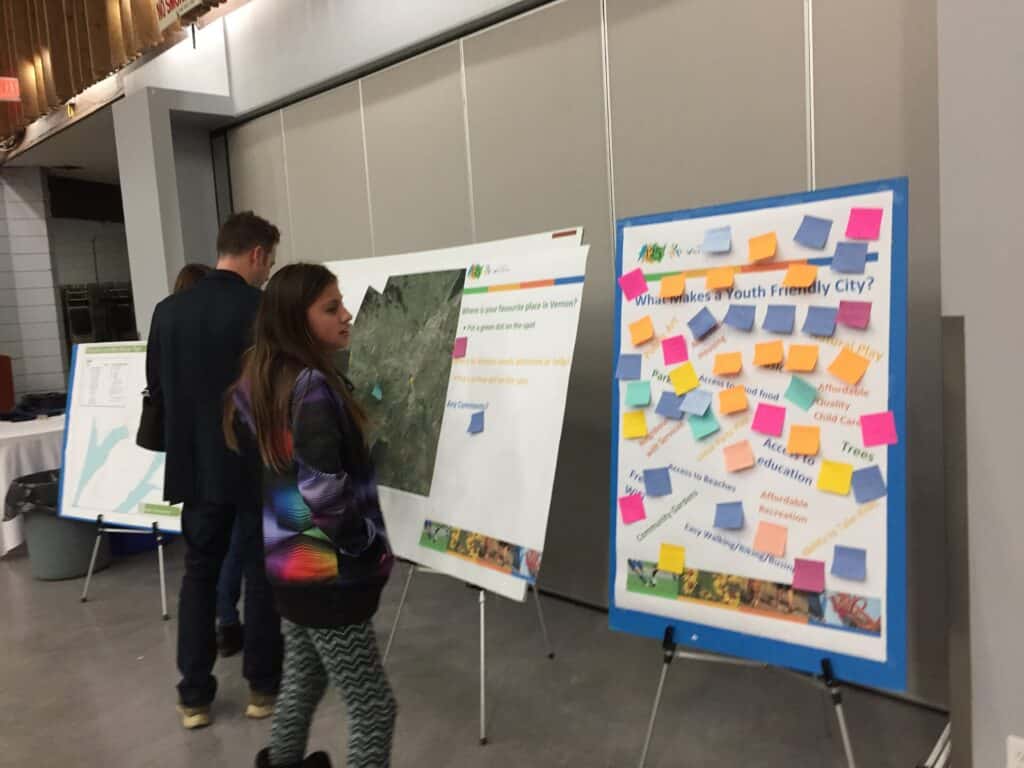“It is easier to build strong children than to repair broken [adults]” Frederic Douglas – 1855
Foundations matter, and so when a community builds a program they must pay attention to what they build on. Vernon, a city of 40,000 in the Okanagan, knew this well when residents started to transform their city into a Child and Youth Friendly Community in 2017. Vernon sought the best practical and academic advice it could, and found models to emulate from across the European Union, and in BC as well – New Westminster, North Vancouver and Richmond.
While Vernon has just begun its Child and Youth Friendly engagement process, Cleo Corbett, Long Range Planner for the City of Vernon, explained that official engagement with child-focused policies goes back at least 15 years, when in 2003 Vernon joined the North Okanagan Early Years Council. Then, in 2007, council amended its Official Community Plan’s guiding principles to include “Create a youth friendly city.” (OCP). Five years later, in 2012, council adopted Vernon’s Children’s Charter. And in 2014, Vernon hosted Cities Fit for Children Summit, which brought delegates from throughout the province to hear renowned speakers discuss how cities can support children, youth and families.
“The summit energized the community,” Corbett said. “It inspired us to take concrete actions. After the Summit we wanted policies: measurable and tangible steps that local government could take to support children and youth in our community.”
When the summit ended, the sub-committee from the event continued to work towards these goals, however, as Corbett noted, this work happened informally – “off the side of our desks.” What Vernon needed was a project coordinator. So, when support from the BC Healthy Communities’ PlanH initiative arose, the community leapt at the chance.
“What we’re doing now with the grant money,” said Corbett, “is analysing our existing policies to see what we are doing well, where the gaps are, and how we can improve.” To do this review, Vernon recruited a lot of help, and will collaborate with a wide array of organizations, including the Interior Health Authority, which has provided local health data, best practices, gold standards, facilitation and consultation support, as well as connected stakeholders. Other organizations include the Society for Children and Youth of BC, whose booklet Vernon will use in its analysis. It contains a step-by-step process for developing new policy, as well as an assessment tool for existing policy and a reference with supplemental information.
The Human Early Learning Partnership (HELP) at the University of British Columbia (UBC), will provide research data and additional best practice guidelines. And from UBC Okanagan’s Institute for Community Engaged Research, fourth-year undergrad students will assist with research focused on urban design and the built environment, cultural safety and truth and reconciliation, and food security. (4)
The City will also collaborate with many local organizations with which it already had strong relationships, like the Boys and Girls Club, School District #22, and the Okanagan Indian Band. With the Band, Vernon hopes to partner to address reconciliation, and reflect the findings of the Truth and Reconciliation Report, by modifying its Children’s Charter to reflect Indigenous youth.
Other outcomes that Vernon plans for include:
- increased use of park space, public space, recreation program participation
- increased use of alternative transportation
- increased affordable housing, development with common space for families
- increasing the number of new families moving to Vernon
- practical and innovative ways to support families, and in particular those marginalized groups with children in the community
While still early days in the process, on November 20th, 2017, National Child Day, Vernon held a five-year anniversary party to celebrate its Children’s Charter, and to host its first of many planned engagement events. Managed in part by youth volunteers, including Carson Armitage, the youth member of the planning committee and grade 11 student at Vernon Community School, over 300 people attended. Everyone was invited to offer their definition of a child friendly city, as well as participate in an asset-mapping activity where they placed yellow and green stickers on a city map. Green stickers indicated a favorite spot and yellow, a place that needed some care.
Over the coming months, more engagement and asset mapping is planned that will include opportunities for everyone in the community to contribute, especially children and youth. This will include online and paper surveys, as well as the innovative website engagevernon.ca, that consolidates all community engagement. Not only can citizens complete the online surveys, but the website also gives citizens important information about each project like timelines and relevant documents, and allows for commenting and other feedback. The website will further assist Vernon to track information, and Vernon hopes to share it with other communities.
“Big picture,” explains Corbett, “children are often not included in civic business, public engagement or design processes. Kids have really simple needs: make public spaces that can accommodate running, jumping, spinning, and children using the space will be happier. And, if you design a public space thinking of children, it will often work for seniors and the mobility challenged as well.”
A great example of this type of design is the small park that Vernon constructed next to a transit terminus downtown. With a playground, musical instruments, benches and washrooms, everyone can enjoy waiting for the bus.
This is the type of project that citizens of Vernon can anticipate once this analysis is finished – a physical and social infrastructure grounded in children’s rights, best practice, and the views of Vernon’s own youth. Vernon will be a city with a solid foundation for children to grow and succeed.




